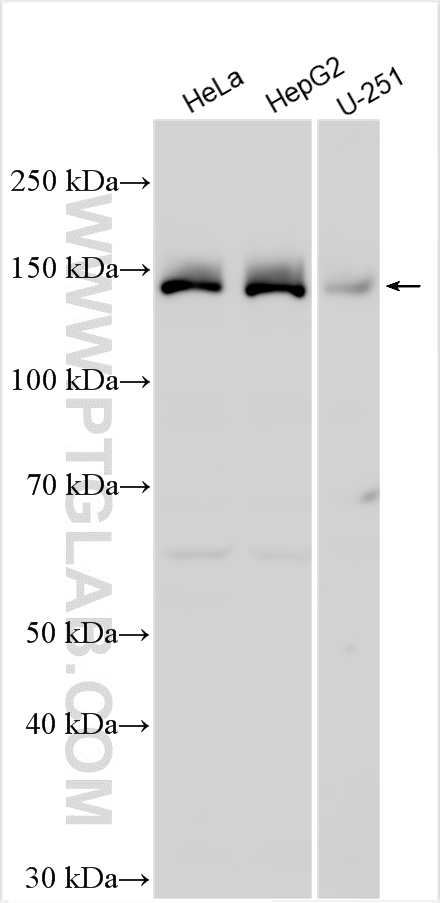验证数据展示
经过测试的应用
| Positive WB detected in | HeLa cells, HepG2 cells, U-251 cells |
推荐稀释比
| 应用 | 推荐稀释比 |
|---|---|
| Western Blot (WB) | WB : 1:2000-1:12000 |
| It is recommended that this reagent should be titrated in each testing system to obtain optimal results. | |
| Sample-dependent, Check data in validation data gallery. | |
产品信息
31705-1-AP targets IKBKAP in WB, ELISA applications and shows reactivity with Human samples.
| 经测试应用 | WB, ELISA Application Description |
| 经测试反应性 | Human |
| 免疫原 | IKBKAP fusion protein Ag35286 种属同源性预测 |
| 宿主/亚型 | Rabbit / IgG |
| 抗体类别 | Polyclonal |
| 产品类型 | Antibody |
| 全称 | inhibitor of kappa light polypeptide gene enhancer in B-cells, kinase complex-associated protein |
| 别名 | IKK complex associated protein, IKAP, FLJ12497, ELP1, Elongator complex protein 1 |
| 计算分子量 | 150kDa,1332aa |
| 观测分子量 | 140-150 kDa |
| GenBank蛋白编号 | NM_001318360.1 |
| 基因名称 | IKBKAP |
| Gene ID (NCBI) | 8518 |
| RRID | AB_3670089 |
| 偶联类型 | Unconjugated |
| 形式 | Liquid |
| 纯化方式 | Antigen affinity Purification |
| UNIPROT ID | O95163 |
| 储存缓冲液 | PBS with 0.02% sodium azide and 50% glycerol , pH 7.3 |
| 储存条件 | Store at -20°C. Stable for one year after shipment. Aliquoting is unnecessary for -20oC storage. |
背景介绍
IKBKAP, also known as ELP1. It is expected to be located in the cytoplasm and nucleus, which is ubiquitinated in adrenal and ovary tissue. The protein encoded by this gene is a scaffold protein and a regulator for three different kinases involved in proinflammatory signaling. The encoded protein can bind NF-kappa-B-inducing kinase and I-kappa-B kinases through separate domains and assemble them into an active kinase complex. Mutations in this gene have been associated with familial dysautonomia. And it exists in homodimer. The molecular weight of IKBKAP is 150 kDa.
实验方案
| Product Specific Protocols | |
|---|---|
| WB protocol for IKBKAP antibody 31705-1-AP | Download protocol |
| Standard Protocols | |
|---|---|
| Click here to view our Standard Protocols |
